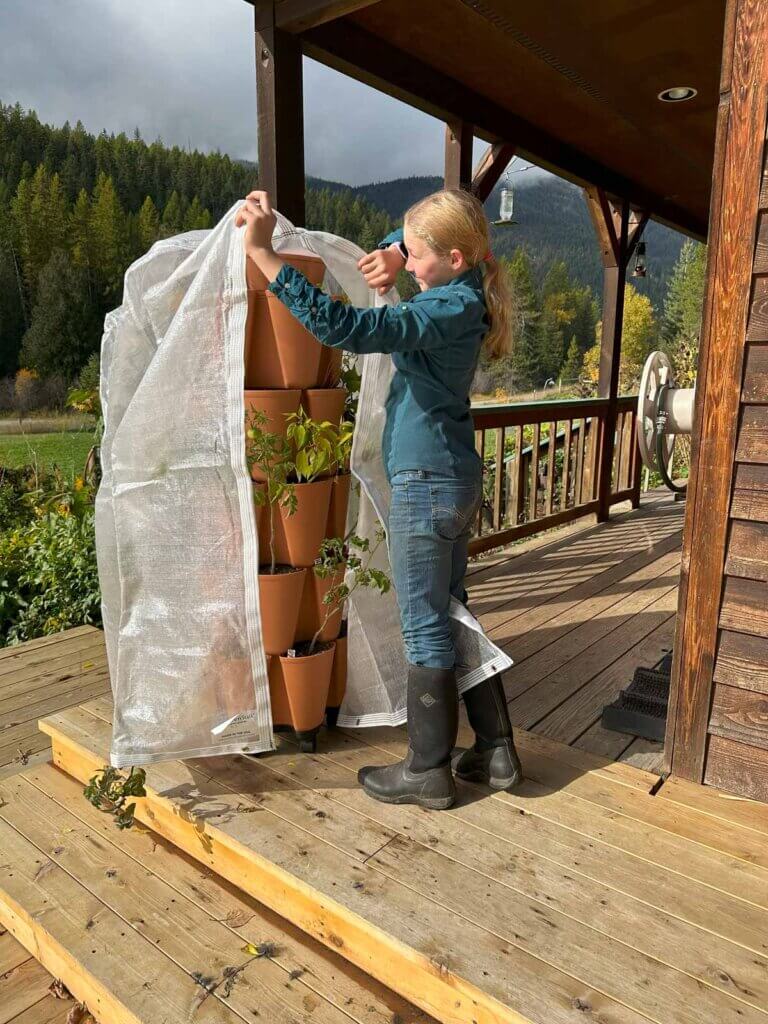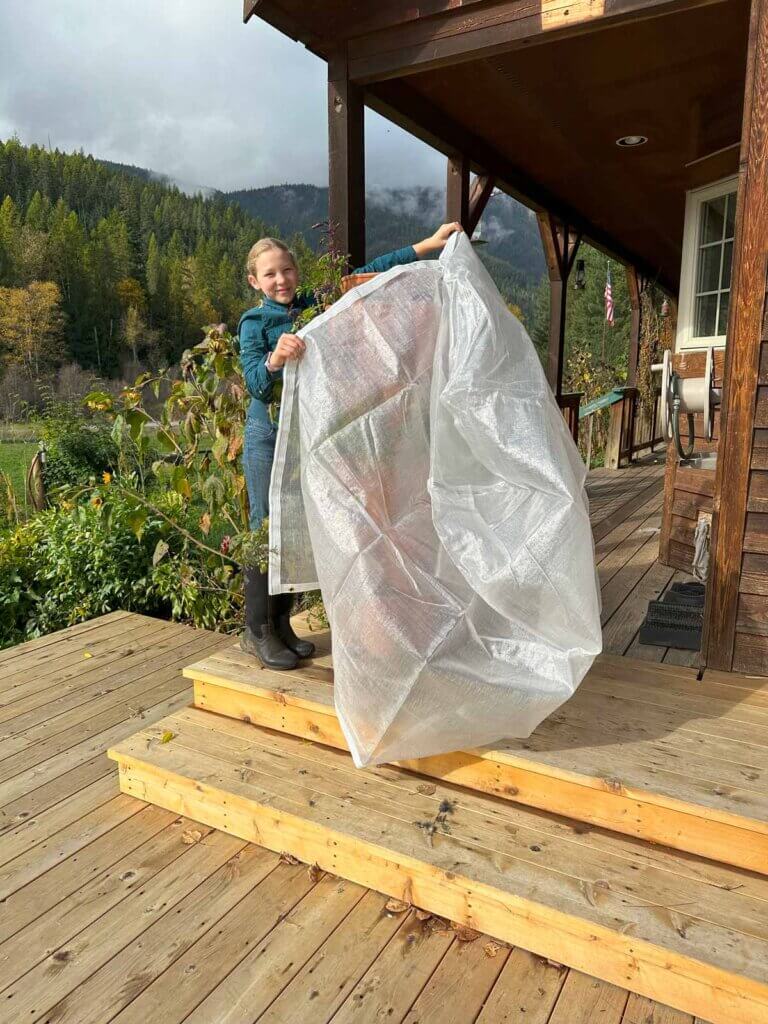Perennials are an excellent investment, allowing you to plant once and harvest for multiple years. However, if you have strawberry, blueberry, raspberry, a rose bush or other perennials growing in containers, a hard freeze can kill these valuable plants.

Container gardening is a great way to get the most growing space out of every square inch of your homestead to accomplish growing a year’s worth of food.
Read on to learn how to winterize plants in pots to protect your perennials from a frigid winter.
Why We Winterize Plants in Pots
When late September’s vibrant fall colors signal it is time to start preparing the homestead for winter, we get busy with winter gardening prep for a better garden next spring.
We continue to grow greens year-round and use cold weather growing methods to keep a thriving winter garden, but some plants need to go into dormancy and rest for the winter before providing food for the coming year.
Hardiness zones of 7 and below are a test for even the most cold-hardy plants, and we must provide as much protection as possible for our outdoor potted plants to survive the winter.
Choosing the best pot for the plant is vital when winterizing your plants in pots.

When to Winterize Potted Plants
According to the zone you live in, let the seasonal weather changes be your guide and forewarn you when it’s time to winterize your potted plants. Watch for frost warnings and severe weather conditions, and start winterizing your potted plants.
A general rule of thumb is to winterize plants in pots for two growing zones below where you live. We live in zones 5 to 6, so the plants that I want to over winter should be suited for zones 3 to 4 if I want them to survive. If your plants cannot survive two zones colder than where you live, you may need to consider bringing your potted plants indoors.

Best Plants to Overwinter
Perennial plants that are zone hardy can be saved throughout the winter with specific methods and precautions, allowing them the best chances for survival.
Perennial plants grown in pots don’t have the insulation from the ground for their root system. The larger amount of soil around the plant when in the ground stays warmer and has better drainage versus when they are grown in pots.
Plants grown in pots are subject to multiple freeze-thaw cycles, stressing root systems, soil conditions and even the pot, depending on its material.

Best Pots for Overwintering
The importance of planting your flowering perennials in winter hardy pots could be life or death.
Porcelain and terra cotta (glazed or unglazed) pots tend to crack during the freeze-thaw cycle and often break when left in the frigid elements of extreme cold. These are best used with annual plants and then emptied and stored well for the winter months.
Containers made of wood, plastic, metal and composite materials will have a better chance of surviving winter weather if left outside. The freeze and thaw action causes contraction and expansion; these materials can handle it.

Supplies Needed
Here are a few tools you can use depending on the method you choose to winterize plants in pots.
- Shovel – Digging holes to place potted plants will require a good shovel.
- Straw – Straw, leaves or mulch helps keep the plant covered for added protection from the elements.
- Rake – Raking the soil, and adding straw and mulch around the plant helps keep the root system protected from the cold.
- Gravel – Good drainage under the root system will give the roots a better chance of survival.
- Pots – The larger the garden pot, the better, providing more soil to protect the roots. Wood, plastic, concrete, metal and foam are suitable for cold-hardy plants.
- Plant Covering – Plastic, burlap and cloth will keep the plant covered and protected when temperatures plummet.
- Bubble Wrap – Wrapping the pots in old blankets, towels, building insulation, or bubble wrap will help keep the roots warmer in the soil.

How to Winterize Plants in Pots
Placing potted plants in the ground is one way to winterize your plants in pots. Another way is placing them in covered and secured places shielded from the harsh weather conditions. We move our large potted rose bushes with these large pot lifters and overwinter them in our uninsulated garage.
Homesteading Hack: Continue to water your plants after your final harvest up until the ground freezes. Moist soil will stay warmer than dry soil, providing more protection for roots.
In-Ground Method
- Dig a hole deeper and wider than the potted plant in your garden or another protected location around your property.
- Line the hole with gravel so the pot can sit on top of it versus sitting on the soil. Doing this helps with drainage and keeps the pot from exposure to frozen soil.
- Place the potted plant into the hole and fill in with the soil until the entire pot is covered.
- Rake the straw or mulch a couple of inches thick on top of the buried pot.
Above Ground Method
- Wrap the pot with the protective covering you have chosen; bubble wrap, old blankets or towels for added protection from the elements.
- Cover the plants in the garden or outside in a protected area with burlap or frost cover for protection. Homesteading Hack: Plastic can sweat and create unwanted moisture; make sure you remove it daily or after threat of frost has passed for airflow if this happens.
- If the pot is small enough to move, place it under an eave on the north or east sides of a building and group pots together for added protection.
- If you bring the potted plants inside for winter, use an unheated garage, basement or a place where they will go and stay dormant for the winter. Heat and too much sunlight will weaken the plants, so you want to avoid southern and western exposures. If a plant comes out of dormancy too soon, it will not do as well in the spring when moved outside.

Greenstalk Vertical Garden
The Greenstalk Vertical Garden accommodates a variety of vegetables and herbs, and the sturdy design can easily move around so you can position it in sunshine or shade.
Also, the unique watering system (along with their new automatic watering system) makes growing a garden almost hands-off.
Greenstalk makes a custom frost protection cover when winterizing potted plants. If you order using this link to Greenstalk Vertical Garden and add the frost protection cover, you will receive $10 off your order when you add the code “homesteadingfamily” at checkout!



















